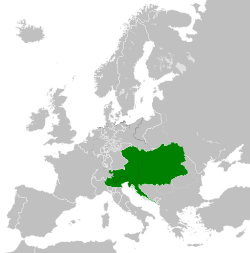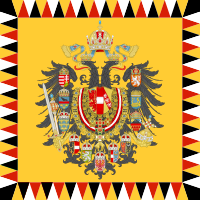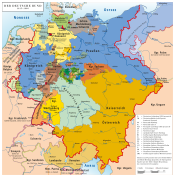Austrian Empire
This article includes a list of general references, but it lacks sufficient corresponding inline citations. (December 2021) |
| History of Austria |
|---|
 |
|
|
The Austrian Empire,[a] officially known as the Empire of Austria, was a multinational European great power from 1804 to 1867, created by proclamation out of the realms of the Habsburgs. During its existence, it was the third most populous monarchy in Europe after the Russian Empire and the United Kingdom, while geographically, it was the third-largest empire in Europe after the Russian Empire and the First French Empire.
The empire was proclaimed by Francis II in 1804 in response to Napoleon's declaration of the First French Empire, unifying all Habsburg possessions under one central government. It remained part of the Holy Roman Empire until the latter's dissolution in 1806. It continued fighting against Napoleon throughout the Napoleonic Wars, except for a period between 1809 and 1813, when Austria was first allied with Napoleon during the invasion of Russia and later neutral during the first few weeks of the Sixth Coalition War. Austria and its allies emerged victorious in the war, leading to the Congress of Vienna, which reaffirmed the empire as one of the great powers of the 19th century.
The Kingdom of Hungary—as Regnum Independens—was administered by its own institutions separately from the rest of the empire. After Austria was defeated in the Austro-Prussian War of 1866, the Austro-Hungarian Compromise of 1867 was adopted, joining the Kingdom of Hungary and the Empire of Austria to form Austria-Hungary.
History
[edit]Foundation
[edit]Changes shaping the nature of the Holy Roman Empire took place during conferences in Rastatt (1797–1799) and Regensburg (1801–1803). On 24 March 1803, the Imperial Recess (German: Reichsdeputationshauptschluss) was declared, which reduced the number of ecclesiastical states from 81 to only 3 and the free imperial cities from 51 to 6. This measure was aimed at replacing the old constitution of the Holy Roman Empire, but the actual consequence of the Imperial Recess, along with the French occupying the Electorate of Hanover in the same month and various Holy Roman states becoming allied with or against France, was the end of the empire.[2] Taking this significant change into consideration, Holy Roman Emperor Francis II created the title Emperor of Austria for himself and his successors, thereby becoming Francis I of Austria. This new title and state were created to safeguard his dynasty's imperial status as he foresaw either the end of the Holy Roman Empire, or the eventual accession of Napoleon as Holy Roman Emperor, who had earlier that year adopted the title Emperor of the French and established the First French Empire. Initially Francis II/I continued to hold both titles but abdicated the throne of the Holy Roman Empire in 1806.
This new empire or "Kaiserthum" (lit. 'Kaiser-dom') comprised all the lands of the Habsburg monarchy, which had until then been legally separate realms in personal union (a composite monarchy) under Francis and his predecessors. By contrast, the Austrian Empire was legally a single state, although the overarching structure and the status of its component lands at first stayed much the same as they had been under the composite monarchy. This was especially demonstrated by the status of the Kingdom of Hungary, a country that had never been a part of the Holy Roman Empire and which had always been considered a separate realm – a status that was affirmed by Article X, which was added to Hungary's constitution in 1790 and described the state as a Regnum Independens. Hungary's affairs remained administered by its own institutions (King and Diet) as they had been beforehand; thus no Imperial institutions were involved in its government.[3][4][5]
The fall and dissolution of the Holy Roman Empire was accelerated by French intervention in the Empire in September 1805. On 20 October 1805, an Austrian army led by General Karl Mack von Leiberich was defeated by French armies near the city of Ulm. The French victory resulted in the capture of 20,000 Austrian soldiers and many cannons. Napoleon's army won another victory at Austerlitz on 2 December 1805. Francis was forced into negotiations with the French from 4 to 6 December 1805, which concluded with an armistice on 6 December 1805.
The French victories encouraged rulers of certain imperial territories to ally themselves with the French and assert their formal independence from the Empire. On 10 December 1805, Maximilian IV Joseph, the prince-elector and Duke of Bavaria, proclaimed himself king, followed by the Duke of Württemberg Frederick III on 11 December. Charles Frederick, Margrave of Baden, was given the title of Grand Duke on 12 December. Each of these new states became French allies.[6]
Francis II agreed to the humiliating Treaty of Pressburg, signed in Pressburg (today Bratislava, Slovakia) on 26 December 1805, in which he recognised these new titles and ceded large amounts of territory to Napoleon's German allies and the French Satellite Kingdom of Italy. In practice this meant the dissolution of the long-lived Holy Roman Empire and a reorganization under a Napoleonic model of the German states. Austrian claims on those German states were renounced without exception.
On 12 July 1806, the Confederation of the Rhine was established, comprising 16 sovereigns and countries. This confederation, under French influence, de facto put an end to the Holy Roman Empire. On 6 August 1806, Francis proclaimed the dissolution of the Holy Roman Empire, as he did not want Napoleon to succeed him.
The dissolution of the Holy Roman Empire was not recognized by George III of the United Kingdom who was also the Elector of Hanover (formally Brunswick-Lüneburg) and Duke of Saxe-Lauenburg; Hanover and Lauenburg were incorporated into the French satellite Kingdom of Westphalia in 1807, having been occupied several times since 1801, but Britain remained at war with France and no treaty was signed recognising their annexation. His claims were later settled by the creation of the Kingdom of Hanover which was held by George IV and William IV as Kings of Hanover. Succession could only be in the male line, so on Queen Victoria's accession to the British throne, her uncle, Ernest Augustus, succeeded as King of Hanover, thus ending the personal union with Great Britain that dated to 1714.
Metternich era
[edit]Klemens von Metternich became Foreign Minister in 1809. He also held the post of Chancellor of State from 1821 until 1848, under both Francis I and his son Ferdinand I. The period of 1815–1848 is also referred to as the "Age of Metternich".[7] During this period, Metternich controlled the Habsburg monarchy's foreign policy. He also had a major influence in European politics. He was known for his strong conservative views and approach in politics. Metternich's policies were strongly against revolution and liberalism.[8] In his opinion, liberalism was a form of legalized revolution.[9] Metternich believed that absolute monarchy was the only proper system of government.[7] This notion influenced his anti-revolutionary policy to ensure the continuation of the Habsburg monarchy in Europe. Metternich was a practitioner of balance-of-power diplomacy.[10] His foreign policy aimed to maintain international political equilibrium to preserve the Habsburgs' power and influence in international affairs. Following the Napoleonic Wars, Metternich was the chief architect of the Congress of Vienna in 1815.[10] The Austrian Empire was the main beneficiary from the Congress of Vienna and it established an alliance with Britain, Prussia, and Russia forming the Quadruple Alliance.[8] The Austrian Empire also gained new territories from the Congress of Vienna, and its influence expanded to the north through the German Confederation and also into Italy.[8] Due to the Congress of Vienna in 1815, Austria was the leading member of the German Confederation.[11] Following the Congress, the major European powers agreed to meet and discuss resolutions in the event of future disputes or revolutions. Because of Metternich's main role in the architecture of the Congress, these meetings are also referred to as the "Metternich congress" or "Metternich system". Under Metternich as the Austrian foreign minister, other congresses would meet to resolve European foreign affairs. These included the Congresses of Aix-la-Chapelle (1818), Carlsbad (1819), Troppau (1820), Laibach (1821), and Verona (1822).[7] The Metternich congresses aimed to maintain the political equilibrium among the European powers and prevent revolutionary efforts. These meetings also aimed to resolve foreign issues and disputes without resorting to violence. By means of these meetings and by allying the Austrian Empire with other European powers whose monarchs had a similar interest in preserving conservative political direction, Metternich was able to establish the Austrian Empire's influence on European politics. Also, because Metternich used the fear of revolutions among European powers, which he also shared, he was able to establish security and predominance of the Habsburgs in Europe.[8]
Under Metternich, nationalist revolts in Austrian north Italy and in the German states were forcibly crushed. At home, he pursued a similar policy to suppress revolutionary and liberal ideals. He employed the Carlsbad Decrees of 1819, which used strict censorship of education, press and speech to repress revolutionary and liberal concepts.[7] Metternich also used a wide-ranging spy network to dampen down unrest.
Metternich operated very freely with regard to foreign policy under Emperor Francis I's reign. Francis died in 1835. This date marks the decline of Metternich's influence in the Austrian Empire. Francis' heir was his son Ferdinand I, but he suffered from health issues. Ferdinand's accession preserved the Habsburg dynastic succession, but he was not capable of ruling.[8] The leadership of the Austrian Empire was transferred to a state council composed of Metternich, Francis I's brother Archduke Louis, and Count Franz Anton Kolowrat, who later became the first Minister-President of the Austrian Empire. The liberal Revolutions of 1848 in the Austrian Empire forced Metternich's resignation. Metternich is remembered for his success in maintaining the status quo and the Habsburg influence in international affairs.[7] No Habsburg foreign minister following Metternich held a similar position within the empire for such a long time nor held such a vast influence on European foreign affairs.[8]
Historians generally consider the Metternich era as a period of stability: the Austrian Empire fought no wars nor did it undergo any radical internal reforms.[12] However, it was also thought of as a period of economic growth and prosperity in the Austrian Empire.[12] The population of Austria rose to 37.5 million by 1843. Urban expansion also occurred and the population of Vienna reached 400,000. During the Metternich era, the Austrian Empire also maintained a stable economy and reached an almost balanced budget, despite having a major deficit following the Napoleonic Wars.[13]
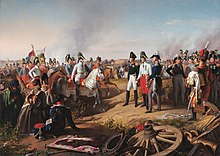
Revolutions of 1848
[edit]From March 1848 through November 1849, the Empire was threatened by revolutionary movements, most of which were of a nationalist character. Besides that, liberal and even socialist currents resisted the empire's longstanding conservatism. Although most of the revolution plans failed, some changes were made; significant lasting reforms included the abolition of serfdom, cancellation of censorship and a promise made by Ferdinand I of Austria said to implement a constitution throughout the whole Empire.[14]
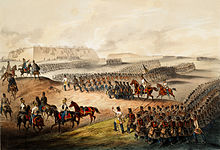
The Bach years
[edit]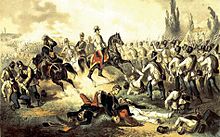
After the death of Prince Felix of Schwarzenberg in 1852, the Minister of the Interior Baron Alexander von Bach largely dictated policy in Austria and Hungary. Bach centralized administrative authority for the Austrian Empire, but he also endorsed reactionary policies that reduced freedom of the press and abandoned public trials. He later represented the Absolutist (or Klerikalabsolutist) party, which culminated in the concordat of August 1855 that gave the Roman Catholic Church control over education and family life. This period in the history of the Austrian Empire would become known as the era of neo-absolutism, or Bach's absolutism.
The pillars of the so-called Bach system (Bachsches System) were, in the words of Adolf Fischhof, four "armies": a standing army of soldiers, a sitting army of office holders, a kneeling army of priests and a fawning army of sneaks.[citation needed] Prisons were full of political prisoners, like Czech nationalist journalist and writer Karel Havlíček Borovský who was forcibly expatriated (1851–1855) to Brixen. This exile undermined Borovský's health and he died soon afterwards. This affair earned Bach a very bad reputation among Czechs and subsequently led to the strengthening of the Czech national movement.[citation needed]
However, Bach's relaxed ideological views (apart from the neo-absolutism) led to a great rise in the 1850s of economic freedom. Internal customs duties were abolished, and peasants were emancipated from their feudal obligations.[15]
In her capacity as leader of the German Confederation, Austria participated with volunteers in the First War of Schleswig (1848–1850).[11]
Sardinia allied itself with France for the conquest of Lombardy–Venetia. Austria was defeated in the 1859 armed conflict. The Treaties of Villafranca and Zürich removed Lombardy, except for the part east of the Mincio river, the so-called Mantovano.[16]
After 1859
[edit]The Constitution of 1861, also known as "February Patent", created a House of Lords (Herrenhaus) and a House of Deputies (Abgeordnetenhaus). But most nationalities of the monarchy remained dissatisfied.[17]
After the second war with Denmark in 1864, Holstein came under Austrian administration, and Schleswig and Lauenburg under Prussian administration. But the internal difficulties continued.[18] Diets replaced the parliament in 17 provinces, the Hungarians pressed for autonomy, and Venetia was attracted by the now unified Italy.
After the Austrian army was defeated in the Austro-Prussian War of 1866 and the German Confederation was dissolved, the Austro-Hungarian Compromise of 1867 was adopted. By this act, the Kingdom of Hungary and the Empire of Austria as two separate entities joined on an equal basis to form the Dual Monarchy of Austria-Hungary. The frequent abbreviation K.u.K. (Kaiserliche und Königliche, "Imperial and Royal") does not refer to that dual monarchy but originated in 1745, when the "royal" part referred to the Apostolic Kingdom of Hungary.[citation needed] However, during World War I Austria-Hungary issued military stamps for use in occupied regions, with the text "K.u.K. Feldpost" or K.u.K. Militärpost.
-
Imperial standard of the Austrian Empire with the lesser coat of arms (used until 1915 for Austria-Hungary)
-
Imperial standard of the Austrian Empire with the medium coat of arms (used until 1915 for Austria-Hungary)
-
Merchant ensign from 1786 until 1869 and naval and war ensign from 1786 until 1915 (de jure, de facto until 1918)
Foreign policy
[edit]
The Napoleonic Wars dominated Austrian foreign policy from 1804 to 1815. The Austrian army was one of the most formidable forces the French had to face. After Prussia signed a peace treaty with France on 5 April 1795, Austria was forced to carry the main burden of war with Napoleonic France for almost ten years. This severely overburdened the Austrian economy, making the war greatly unpopular. Emperor Francis I therefore refused to join any further war against Napoleon for a long time. On the other hand, Francis I continued to intrigue for the possibility of revenge against France, entering into a secret military agreement with the Russian Empire in November 1804. This convention was to assure mutual cooperation in the case of a new war against France.[19]
Austrian unwillingness to join the Third Coalition was overcome by British subsidies, but the Austrians withdrew from the war yet again after a decisive defeat at the Battle of Austerlitz. Although the Austrian budget suffered from wartime expenditures and its international position was significantly undermined, the humiliating Treaty of Pressburg provided plenty of time to strengthen the army and economy. Moreover, the ambitious Archduke Charles and Johann Philipp von Stadion never abandoned the goal of further war with France.[citation needed]

Archduke Charles of Austria served as the Head of the Council of War and Commander in Chief of the Austrian army. Endowed with the enlarged powers, he reformed the Austrian Army to preparedness for another war. Johann Philipp von Stadion, the foreign minister, personally hated Napoleon due to an experience of confiscation of his possessions in France by Napoleon. In addition, the third wife of Francis I, Maria Ludovika of Austria-Este, agreed with Stadion's efforts to begin a new war. Klemens Wenzel von Metternich, located in Paris, called for careful advance in the case of the war against France. The defeat of French army at the Battle of Bailén in Spain on 27 July 1808 triggered the war. On 9 April 1809, an Austrian force of 170,000 men attacked Bavaria.[20]
Despite military defeats of the Austrian army—especially the Battles of Marengo, Ulm, Austerlitz and Wagram—and consequently lost territory throughout the Revolutionary and Napoleonic Wars (the Treaties of Campo Formio in 1797, Luneville in 1801, Pressburg in 1806, and Schönbrunn in 1809), Austria played a decisive part in the overthrow of Napoleon in the campaigns of 1813–14. It participated in a second invasion of France in 1815, and put an end to Murat's regime in south Italy.[citation needed]
The latter period of Napoleonic Wars featured Metternich exerting a large degree of influence over foreign policy in the Austrian Empire, a matter nominally decided by the Emperor. Metternich initially supported an alliance with France, arranging the marriage between Napoleon and Francis I's daughter, Marie-Louise; however, by the 1812 campaign, he had realised the inevitability of Napoleon's downfall and took Austria to war against France. Metternich's influence at the Congress of Vienna was remarkable, and he became not only the premier statesman in Europe but the virtual ruler of the Empire until 1848—the Year of revolutions—and the rise of liberalism equated to his political downfall. The result was that the Austrian Empire was seen as one of the great powers after 1815, but also as a reactionary force and an obstacle to national aspirations in Italy and Germany.[21]
During this time, Metternich was able to maintain an elaborate balance between Prussia, the lesser German states, and Austria in the German Confederation. Thanks to his efforts, Austria was seen as the senior partner with Prussia keeping watch over Germany as a whole. Further, Metternich opposed the weakening of France in the years after Napoleon, and viewed the new monarchy in Paris as an effective tool in keeping Russia at bay. From 1815 to 1848, Metternich steered Austria Imperial foreign policy, and indeed the mood of Europe, and managed to keep peace on the continent despite the growing liberal and radical movements inside most major powers. His resignation in 1848, forced by moderates in the court, and revolutionaries in the streets, may have caused the spread of the revolutions throughout the monarchy. It is stipulated that Metternich's departure emboldened liberal factions in Austria and Hungary, but this cannot be confirmed for certain.
During the Crimean War, Austria maintained a policy of hostile neutrality towards Russia, and, while not going to war, was supportive of the Anglo-French coalition. Having abandoned its alliance with Russia, Austria was diplomatically isolated following the war, which contributed to Russia's non-intervention in the 1859 Franco-Austrian War, which meant the end of Austrian influence in Italy; and in the 1866 Austro-Prussian War, with the loss of its influence in most German-speaking land.[22]
Constituent lands
[edit]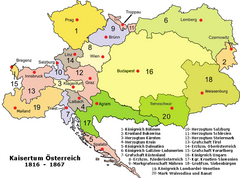


Crown lands of the Austrian Empire after the 1815 Congress of Vienna, including the local government reorganizations from the Revolutions of 1848 to the 1860 October Diploma:
- Archduchy of Austria (Erzherzogtum Österreich)
- Lower Austria (Erzherzogtum Österreich unter der Enns)
- Upper Austria (Erzherzogtum Österreich ob der Enns)
- Duchy of Salzburg (Herzogtum Salzburg), 1815–1850 Salzach District (Salzachkreis) of Upper Austria
- Duchy of Styria (Herzogtum Steiermark)
- Princely County of Tyrol with Vorarlberg (Gefürstete Grafschaft Tirol mit dem Lande Vorarlberg), subdivided in 1861
- Kingdom of Illyria (Königreich Illyrien), subdivided in 1849/1850:
- Duchy of Carinthia (Herzogtum Kärnten)
- Duchy of Carniola (Herzogtum Krain)
- Littoral (Küstenland)
- Princely County of Gorizia and Gradisca (Gefürstete Grafschaft Görz und Gradisca)
- Imperial Free City of Trieste (Triest)
- Margraviate of Istria (Markgrafschaft Istrien)
- Lands of the Bohemian Crown
- Kingdom of Bohemia (Königreich Böhmen)
- Margraviate of Moravia (Markgrafschaft Mähren)
- Duchy of Silesia (Herzogtum Schlesien)
- Kingdom of Galicia and Lodomeria (Königreich Galizien und Lodomerien) with
- Duchy of Bukovina (Herzogtum Bukowina), split off in 1850
- Kingdom of Dalmatia (Königreich Dalmatien)
- Kingdom of Hungary (Königreich Ungarn) with
- Kingdom of Croatia (Königreich Kroatien)
- Kingdom of Slavonia (Königreich Slawonien)
- City of Fiume with its territory (Stadt Fiume mit Gebiet), Corpus separatum under Hungary from 1779; part of French Illyrian Provinces from 1809 then Kingdom of Illyria; restored to Hungary in 1822; to Croatia 1849
- Kingdom of Lombardy–Venetia (Lombardo-Venezianisches Königreich), lost in 1859/1866
- Grand Principality of Transylvania (Großfürstentum Siebenbürgen)
- Voivodeship of Serbia and Banat of Temeschwar (Woiwodschaft Serbien und Temescher Banat), from 1849, merged into Hungary and Slavonia in 1860
- Serbian Vojvodina, de facto autonomous entity 1848/49, not officially recognized
- Banat of Temeschwar (Banat)
- Military Frontier (Militärgrenze)
- Croatian Military Frontier (Kroatische Militärgrenze)
- Slavonian Military Frontier (Slawonische Militärgrenze)
- Banat Military Frontier (Banater Militärgrenze)
- Transylvanian Military Frontier (Siebenbürger Militärgrenze) merged into Transylvania in 1853
The old Habsburg possessions of Further Austria (in today's France, Germany and Switzerland) had already been lost in the 1805 Peace of Pressburg.
From 1850, Croatia, Slavonia, and the Military Frontier constituted a single land with disaggregated provincial and military administration, and representation.[23]
Administratively, most of the crown lands excluding Hungary, Croatia, Slavonia, Transylvania, Lombardy–Venetia and the Military Frontier were divided into Kreise ('circles'), an administrative division introduced under Maria Theresa in the 18th century. Following the revolutions of 1848 a brief attempt was made to introduce modern-style political districts (in addition to the Kreise),[24] but the reforms of Bach in 1853/54[25] instead instituted a system which delegated the responsibilities of the Kreise among subordinate Amtsbezirke ('office districts'), a system which persisted until 1867.
In the course of the post-1848 reforms Transylvania was also divided into Kreise in 1851[26] (re-divided in 1854[27]); the Voivodeship of Serbia and Banat of Temeschwar was also divided into Kreise.[28]
Education
[edit]German was the primary language of higher education in the empire.[29]
Gallery
[edit]-
The 'hauskrone' of Rudolph II, later the imperial crown of the Austrian Empire
-
The crown jewels of Austria
-
Growth of the Habsburg Monarchy
-
Vereinstaler of 1866
-
Postage stamp depicting Francis I
-
Postage stamp depicting Franz Joseph I
-
Double-headed eagle at the Ministry of War in Vienna
-
Military districts in Hungarian part of the Empire in 1850
See also
[edit]- Former countries in Europe after 1815
- Austria-Hungary
- Cisleithania for the Austrian Empire after the Austro-Hungarian Compromise of 1867
Notes
[edit]- ^ German: Kaiserthum Oesterreich, modern spelling Kaisertum Österreich, pronounced [ˌkaɪzɐtuːm ˈøːstɐraɪç] ⓘ.
References
[edit]- ^ October Diploma
- ^ Williamson, David G. (2016). Germany Since 1789: A Nation Forged and Renewed (2nd ed.). New York: Palgrave Macmillan. p. 14. ISBN 978-1-137-35004-6.
- ^ Laszlo, Péter (2011), Hungary's Long Nineteenth Century: Constitutional and Democratic Traditions, Koninklijke Brill NV, Leiden, the Netherlands, p. 6,
From the perspective of the Court since 1723, regnum Hungariae had been a hereditary province of the dynasty's three main branches on both lines. From the perspective of the ország, Hungary was regnum independens, a separate Land as Article X of 1790 stipulated ........ In 1804, Emperor Franz assumed the title of Emperor of Austria for all the Erblande of the dynasty and for the other Lands, including Hungary. Thus Hungary formally became part of the Empire of Austria. The Court reassured the diet, however, that the assumption of the monarch's new title did not in any sense affect the laws and the constitution of Hungary
- ^ "Vor dem Jahr 1848 is[t] das Kaisertum Österreich verfassungsrechtlich als ein monarchischer Einheitsstaat auf differenziert föderalistischer Grundlage zu sehen, wobei die besondere Stel[l]ung Ungarns im Rahmen dieses Gesamtstaates stets offenkundig war. Eine weitere Differenzierung der föderalistischen Grundlage erfolgte ab 1815 durch die Zugehörigkeit eines teiles des Kaisertums zum Deutschen Bund." "Before 1848 the Austrian Empire can be regarded in constitutional law as a unitary monarchy on a differentiated federalistic basis, whereby the special position of Hungary within the framework of this federal entity was always evident. A further differentiation of the federalistic position followed from 1815 through the affiliation of a part of the empire to the German federation."Zeilner, Franz (2008), Verfassung, Verfassungsrecht und Lehre des Öffentlichen Rechts in Österreich bis 1848: Eine Darstellung der materiellen und formellen Verfassungssituation und der Lehre des öffentlichen Rechts, Lang, Frankfurt am Main, p. 45
- ^ József Zachar, Austerlitz, 1805. december 2. A három császár csatája – magyar szemmel,[permanent dead link] In: Eszmék, forradalmak, háborúk. Vadász Sándor 80 éves, ELTE, Budapest, 2010 p. 557
- ^ "Maximilian I | Duke and Elector of Bavaria (1573-1651) | Britannica". www.britannica.com. 13 April 2024. Retrieved 6 June 2024.
- ^ a b c d e Sked, Alan. The Decline and Fall of the Habsburg Empire, 1815–1918. London: Longman, 1989. Print.
- ^ a b c d e f Jelavich, Barbara. The Habsburg Empire in European Affairs: 1814–1918. Chicago: Rand Mcnally, 1969. Print.
- ^ Tuncer, Huner. "Metternich and the Modern Era." Arts–Culture. Daily News, 6 September 1996. Web. 24 March 2015.
- ^ a b Sofka, James R. "Metternich's Theory of European Order: A Political Agenda for 'Perpetual Peace'." The Review of Politics 60.01 (1998): 115. Web.
- ^ a b Handbook of Austria and Lombardy-Venetia Cancellations on the Postage Stamp Issues 1850–1864, by Edwin Mueller, 1961.
- ^ a b Crankshaw, Edward. The Fall of the House of Habsburg. New York: Viking, 1963. Print.
- ^ "History of Austria, Austria in the Age of Metternich." History of Austria, Austria in the Age of Metternich. N.p., n.d. Web. 24 March 2015.
- ^ "Ferdinand (I) | Biography, Reign, & Facts | Britannica". www.britannica.com. 15 April 2024. Retrieved 28 May 2024.
- ^ Gilman, D. C.; Peck, H. T.; Colby, F. M., eds. (1905). . New International Encyclopedia (1st ed.). New York: Dodd, Mead.
- ^ Mueller 1961, Historical Data, p. H5.
- ^ "February Patent | Austrian history | Britannica". www.britannica.com. Retrieved 28 May 2024.
- ^ Mueller 1961, p. H6.
- ^ Gunther Rothenberg, Napoleon's great adversaries: the Archduke Charles and the Austrian army, 1792–1814 (Indiana UP, 1982).
- ^ Robert Goetz, 1805, Austerlitz: Napoleon and the Destruction of the Third Coalition (2005).
- ^ Josephine Bunch Stearns, The Role of Metternich in Undermining Napoleon (University of Illinois Press, 1948).
- ^ Figes, Orlando (2010). Crimea: The Last Crusade. London: Allen Lane. p. 433. ISBN 978-0-7139-9704-0.
- ^ "Najnovije doba hrvatske povjesti (R. Horvat)/Prelom s Ugarskom – Wikizvor". hr.wikisource.org. Retrieved 15 June 2019.
- ^ Gesetz vom 26. Juni 1849, RGBl. 295/1849: "Kaiserliche Entschließung vom 26. Juni 1849, wodurch die Grunzüge für die Organisation der Politischen Verwaltungs-Behörden genehmiget werden". ÖNB-ALEX – Historische Rechts- und Gesetztexte Online (in German). 26 June 1849. Retrieved 5 July 2023.
- ^ Gesetz vom 19. Jänner 1853, RGBl. 10/1853: "Verordnung der Minister des Inneren, der Justiz und der Finanzen vom 19. Jänner 1853, womit die Allerhöchsten Entschließungen über die Einrichtung und Amtswirksamkeit der Bezirksämter, Kreisbehörden und Statthaltereien, über die Einrichtung der Gerichtsstellen und das Schema der systemisirten Gehalte und Diätenclassen, sowie über die Ausführung der Organisirung für die Kronländer Oesterreich ob und unter der Enns, Böhmen, Mähren, Schlesien, Galizien und Lodomerien mit Krakau, Bukowina, Salzburg, Tirol mit Vorarlberg, Steiermark, Kärnthen, Krain, Görz, Gradiska und Istrien mit Triest, Dalmatien, Kroatien und Slawonien, Siebenbürgen, die serbische Wojwodschaft mit dem Banate, kundgemacht werden". ÖNB-ALEX – Historische Rechts- und Gesetztexte Online (in German). 19 January 1853. Retrieved 5 July 2023.
- ^ "Verordnung des Ministeriums des Inneren vom 12. Mai 1851, wodurch in Folge Allerhöchster Entschließung vom 12. Mai 1851 die Organisirung politischen Verwaltung im Großfürstenthume Siebenbürgen kundgemacht wird". Reichs-Gesetz-Blatt für das Kaiserthum Österreich (in German). 12 May 1851. Retrieved 5 July 2023 – via ÖNB-ALEX – Historische Rechts- und Gesetztexte Online.
- ^ "Verordnung der Minister des Inneren, der Justiz und der Finanzen vom 4. Juni 1854, betreffend die politische und gerichtliche Organisirung des Großfürstenthumes Siebenbürgen". Reichs-Gesetz-Blatt für das Kaiserthum Österreich (in German). 4 June 1854. Retrieved 5 July 2023 – via ÖNB-ALEX – Historische Rechts- und Gesetztexte Online.
- ^ "Verordnung der Minister des Inneren, der Justiz und der Finanzen vom 1. Februar 1854, betreffend die politische und gerichtliche Organisirung der serbischen Woiwodschaft und des Temeser Banates". Reichs-Gesetz-Blatt für das Kaiserthum Österreich (in German). 1 February 1854. Retrieved 5 July 2023 – via ÖNB-ALEX – Historische Rechts- und Gesetztexte Online.
- ^ Strauss, Johann. "Language and power in the late Ottoman Empire" (Chapter 7). In: Murphey, Rhoads (editor). Imperial Lineages and Legacies in the Eastern Mediterranean: Recording the Imprint of Roman, Byzantine and Ottoman Rule (Vol. 18 of Birmingham Byzantine and Ottoman Studies). Routledge, 2016. ISBN 978-1317118442. Google Books PT196.
Further reading
[edit]- Bassett, Richard. For God and Kaiser: The Imperial Austrian Army, 1619–1918 (2016).
- Evans, R. J. W. (2006). Austria, Hungary, and the Habsburgs: Essays on Central Europe, c. 1683–1867. online[permanent dead link]
- Judson, Pieter M. The Habsburg Empire: A New History (2016) excerpt
- Kann, Robert A. (1980). A History of the Habsburg Empire, 1526–1918 (2nd ed.).
- Kissinger, Henry (1955). The World Restored: Metternich, Castlereagh, and the Problems of Peace, 1812–22.
- Okey, Robin (2002). The Habsburg Monarchy, c. 1765–1918: From Enlightenment to Eclipse. excerpt and text search
- Rothenberg, Gunther E. (1976). "Nobility and Military Careers: The Habsburg Officer Corps, 1740–1914". Military Affairs. 40 (4): 182–186. doi:10.2307/1986702. JSTOR 1986702.
- Rothenberg, Gunther E. (1968). "The Austrian Army in the Age of Metternich". Journal of Modern History. 40 (2): 155–165. doi:10.1086/240187. JSTOR 1876727. S2CID 143628536.
- Sked, Alan. "Explaining the Habsburg Empire, 1830–90." in Pamela Pilbeam, ed., Themes in Modern European History 1830–1890 (Routledge, 2002) pp. 141–176.
- Sked, Alan (2008). Metternich and Austria: An Evaluation.
- Sked, Alan (2001). The Decline and Fall of the Habsburg Empire, 1815–1918 (2nd ed.).
- Steed, Henry Wickham. The Hapsburg monarchy (1919) online detailed contemporary account
- Taylor, A.J.P. (1941). The Habsburg Monarchy, 1809–1918: A History of the Austrian Empire and Austria-Hungary. excerpt and text search
External links
[edit]- Austrian Army during the Napoleonic Wars
- The empire of Austria; its rise and present power (Third millennium library)
- Austrian Empire
- House of Habsburg-Lorraine
- States of the German Confederation
- Christian states
- Former countries in the Balkans
- Former empires
- Former monarchies of Europe
- 19th century in Italy
- 19th century in Slovenia
- 19th century in Slovakia
- 19th century in Austria
- 19th century in Bohemia
- 19th century in Hungary
- States and territories established in 1804
- States and territories disestablished in 1867
- 1804 establishments in the Austrian Empire
- 1867 disestablishments in the Austrian Empire



